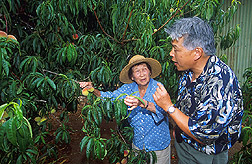This page has been archived and is being provided for reference purposes only. The page is no longer being updated, and therefore, links on the page may be invalid.
Zapping Hawaii's Pesky Fruit Flies, Grid by GridBy Marcia WoodOctober 10, 2002 A quartet of exotic tropical fruit flies--Oriental, melon, Mediterranean and Malaysian-- can easily turn what should be a fresh, luscious tropical fruit or vegetable into a disgusting mess. That's because the fruit flies' tiny, wriggling maggots spoil what would otherwise be a delectable crop. Agricultural Research Service scientists and their University of Hawaii collaborators are targeting these troublesome flies in an Areawide Integrated Pest Management Program on Fruit Flies in Hawaii. The goal is to give Hawaii's growers the latest and best science-based, environmentally sound strategies to reduce crop losses and, at the same time, lessen the need for insecticides. The program will help farmers keep the fruit flies under control in carefully delineated suppression grids. These grids include not only participating growers' fields and orchards, but also nearby vegetation where significant numbers of the fruit flies live and breed, according to ARS entomologist Eric B. Jang. Jang and ARS entomologist Roger I. Vargas lead the program. They are based at the agency's U.S. Pacific Basin Agricultural Research Center in Hilo. The program's approaches for going after fruit flies in the suppression grids are practical, affordable and workable. Using grids is very different from attempting to obliterate the fruit flies everywhere they live in the Hawaiian Islands chain. Today, ARS scientists and co-investigators are employing such control methods as sanitation, to remove as much infested fruit as possible, and male annihilation, accomplished with traps that contain a lure that's irresistible to male fruit flies plus a second compound that kills them once they touch or eat it. Other control techniques include applying protein-based bait sprays, which are added to a compound that kills the flies, and rearing and releasing a beneficial wasp, Fopius arisanus, that attacks fruit flies. In addition, scientists are turning loose laboratory-reared, sexually sterile, male melon flies to mate with wild, fertile females. That causes melon fly populations to crash, according to ARS geneticist Donald O. McInnis. For this purpose, McInnis developed a unique, exclusively male line of melon flies at the center's Honolulu laboratory. ARS is the U.S. Department of Agriculture's chief scientific research agency. |

